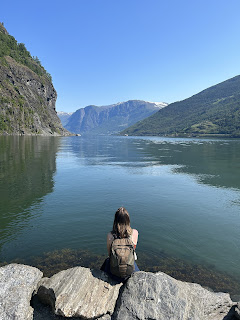London 1
London 1
Great Ideas of Friendship & the Link Between Waterway Health and Human Health
May 17, 2023 -- the day I embarked on one of the Greatest adventures of my life, my Great Ideas Tour of the waterways of Western Europe. I remember my anticipation throughout the flight: what would this summer turn out to be like? Who would I meet? What would I learn? How would it feel to live out so many lifelong dreams over the course of 89 days? Now, I have those answers, and I am thrilled to share my summer with you!
Filled with excitement, I was hardly able to sleep as we flew "across the pond." So, when I arrived in London for the first leg of the journey with my dear friend Eli and some other friends of hers, I was tired and jet-lagged. Our first afternoon was spent making our way to our hotel for the next two nights -- I was shocked how familiar the Tube system felt, though last time I was here was during a brief visit during my summer studying abroad in Oxford -- and then taking a walk through Hyde Park and having a lovely first dinner of the trip.
The second, full day in London was a still a bit of a jet-lagged blur. We visited some of the big landmarks including Westminster Abbey, Buckingham Palace, and Big Ben, but my favorite stop was the Westminster Bridge overlooking the powerful River Thames. In 1929, James Burns called the River Thames "liquid history," and it certainly has many stories to tell.
My favorite famous story is the Great Stink in the summer of 1857 (What can I say? I'm a wastewater nerd through and through). The accumulated industrial and human waste that had been dumped into the Thames since the Industrial Revolution began and the city became more populated had become so rancid that people were becoming sick, dying, and trying to get out of London. Parliament itself was literally so filled with the stench that work could hardly be done. In response, policy makers finally took action, hiring Sir Joseph Bazelgette, a civil engineer, to design and implement London's sewage network, which vastly improved public health and environmental conditions in London. The network has since expanded but is still in use today (Woohoo for civil engineers)!
The Thames has faced several challenges since the Great Stink, including being deemed biologically dead in 1957 when there was so much pollution that the River could no longer support aquatic life. Since then, there have been several efforts to reduce pollution input to the river, increase the dissolved oxygen which allows aquatic life to thrive, and to remove litter. The Thames is now able to support fish and other species again, but the water quality could definitely still improve as the River still shoulders significant economic, transportation, and waste burdens. This amazing river continues to serve as the brave backbone of London, and it teaches us a great deal about the importance of properly managing and treating our waste to protect our environment and in turn ourselves. The Thames is a testament to the fact that the health and well-being of humanity is inextricably bound to the health and well-being of our precious water resources.



















Comments
Post a Comment